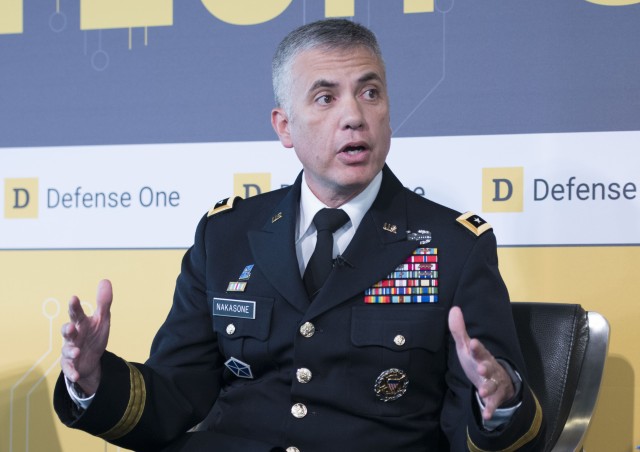WASHINGTON -- Each day, the Army faces "hundreds of thousands" of attempts to infiltrate its network, said Lt. Gen. Paul Nakasone, chief of U.S. Army Cyber Command, also known as ARCYBER.
"We have to be right every single time. The attacker only has to be right once; to find one vulnerability," Nakasone said at the 2017 Defense One Summit in Washington on Thursday, July 13. We're looking at vulnerabilities across our network. We're looking at the key terrain like any military force."
Nakasone, speaking in a panel with Defense One Executive Editor Kevin Baron, faced questions on concerns over possible internet attacks from North Korea, Russia and ISIS, but highlighted the Army's focus on solid analysis as a deterrent to cyber security breaches. "We're looking at vulnerabilities across our network," he assured. "We're looking at the key terrain like any military force."
In the wake of alleged Russian hacks into the 2016 American election, Nakasone said the key to preventing similar threats should come from analysis and research. U.S. Cyber Command, the Department of Defense-wide sub-unified command known as USCYBERCOM, is in the midst of creating 133 cyber teams, including 41 for the Army. To fill these teams with quality analysts, the Army is recruiting leaders with the skills necessary to rise to new cyber security challenges.
Additionally, ARCYBER has participated in exercises at the National Training Center in Fort Irwin, California, to gain a better understanding of what a brigade combat team needs to achieve success at the tactical level of cybersecurity. ARCYBER studied how a BCT commander should use social media and how a team can better defend their networks.
Nakasone mentioned further efforts in the Army's efforts to maintain a robust cyber awareness, including an initiative to bring in 60 new second lieutenants to ARCYBER with a science background. A pending proposal would commission skilled applicants as mid-grade officers. Nakasone said the requirements and perquisites for those positions are still being discussed.
"We are going to need coders, we're going to need malware forensics analysts," Nakasone said. "We are going to need top talent."
To help attract tech-savvy recruits, ARCYBER created an interactive link in a video on the ARCYBER webpage and YouTube Channel, inviting hackers to solve a puzzle. Nakasone said about 800,000 people attempted to solve the puzzle -- less than 1 percent successfully completed it. The link generated 1.3 million hits on ARCYBER's website and 9.8 million views on YouTube.
"We wanted to create an excitement (and) an ability for our best talent in the nation to take a look and want to be part of our force," Nakasone said. "The intent was, how do you generate that excitement? This is one of the ways that we did it."
Nakasone also addressed the importance of artificial intelligence and its impact on operations. "I would love to have a self-healing network; that as soon as we see a vulnerability, it requires very little effort to have that vulnerability patched," Nakasone said. "A.I. can help us with that.
"We are obviously very interested in terms of how do you take a force that is only so big back to the question of resources and make that larger?" Nakasone continued. "Well, one of the ways that you can do that is through artificial intelligence, and how do we get more capability … I certainly believe that's the future for us."
Related Links:
Army.mil: Science and Technology News






Social Sharing